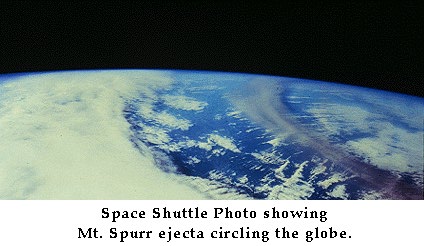|
|
This photo shows the large white billowing eruption plume from Rabaul being carried in a westerly direction by the weak prevailing winds. At the base of the eruption column is a layer of yellow-brown ash being distributed by lower level winds. A sharp boundary moving outward from the center of the eruption in the lower cloud is a pulse of laterally-moving ash which results from a volcanic explosion. Image taken on 09/29/94 from STS-64 (STS64-116-064). Information Source: Shuttle Images at the Johnson Space Center in Houston, Texas.
 |
There are two things to think about. The first is how the weather near an erupting volcano is being affected. The second is how large eruptions will affect the weather/climate around the world. I think more people are worried about the second issue than the first.
The main effect on weather right near a volcano is that there is often a lot of rain, lightning, and thunder during an eruption. This is because all the ash particles that are thrown up into the atmosphere are good at attracting/collecting water droplets. We don’t quite know exactly how the lightning is caused but it probably involves the particles moving through the air and separating positively and negatively charged particles.
Another problem in Hawai’i involves the formation of vog, or volcanic fog. The ongoing eruption there is very quiet, with lava flowing through lava tubes and then into the ocean. Up at the vent is an almost constant plume of volcanic fume that contains a lot of sulfur dioxide. This SO2 combines with water in the atmosphere to form sulfuric acid droplets that get carried in the trade winds around to the leeward side of the Big Island. The air quality there has been really poor since the eruption started in 1983 and they are getting pretty tired of it.
As for the world-wide affects of volcanic eruptions this only happens when there are large explosive eruptions that throw material into the stratosphere. If it only gets into the troposphere it gets flushed out by rain.
The effects on the climate haven’t been completely figured out. It seems to depend on the size of the particles (again mostly droplets of sulfuric acid). If they are big then they let sunlight in but don’t let heat radiated from the Earth’s surface out, and the net result is a warmer Earth (the famous Greenhouse effect). If the particles are smaller than about 2 microns then they block some of the incoming energy from the Sun and the Earth cools off a little. That seems to have been the effect of the Pinatubo eruption where about a 1/2 degree of cooling was noticed around the world. Of course that doesn’t just mean that things are cooler, but there are all kinds of effects on the wind circulation and where storms occur.
An even more controversial connection involves whether or not volcanic activity on the East Pacific Rise (a mid-ocean spreading center) can cause warmer water at the surface of the East Pacific, and in that way generate an El Nino. Dr. Dan Walker here at the University of Hawai’i has noticed a strong correlation between seismic activity on the East Pacific Rise (which he presumes indicates an eruption) and El Nino cycles over the past ~25 years.
CO2
As a long-term average, volcanism produces about 5X10^11 kg of CO2 per year; that production, along with oceanic and terrestrial biomass cycling maintained a carbon dioxide reservoir in the atmosphere of about 2.2X10^15 kg. Current fossil fuel and land use practices now introduce about a (net) 17.6X10^12 kg of CO2 into the atmosphere and has resulted in a progressively increasing atmospheric reservoir of 2.69X10^15 kg of CO2. Hence, volcanism produces about 3% of the total CO2 with the other 97% coming from anthropogenic sources. For more detail, see Morse and Mackenzie, 1990, Geochemistry of Sedimentary Carbonates.
To get into the scientific literature read chapter 17 of Peter Francis’ excellent book, “Volcanoes – A Planetary Perspective.” The 33 references give you the important articles from Ben Franklin to the early 1990s. Good reading!
Thanks to Scott Rowland, Chuck Wood, and Don Thomas for writing this answer! I should note that this was written a few years back and a lot of work has focused on this area recently. Volcano World will be running a special feature on volcanism and climate this summer!